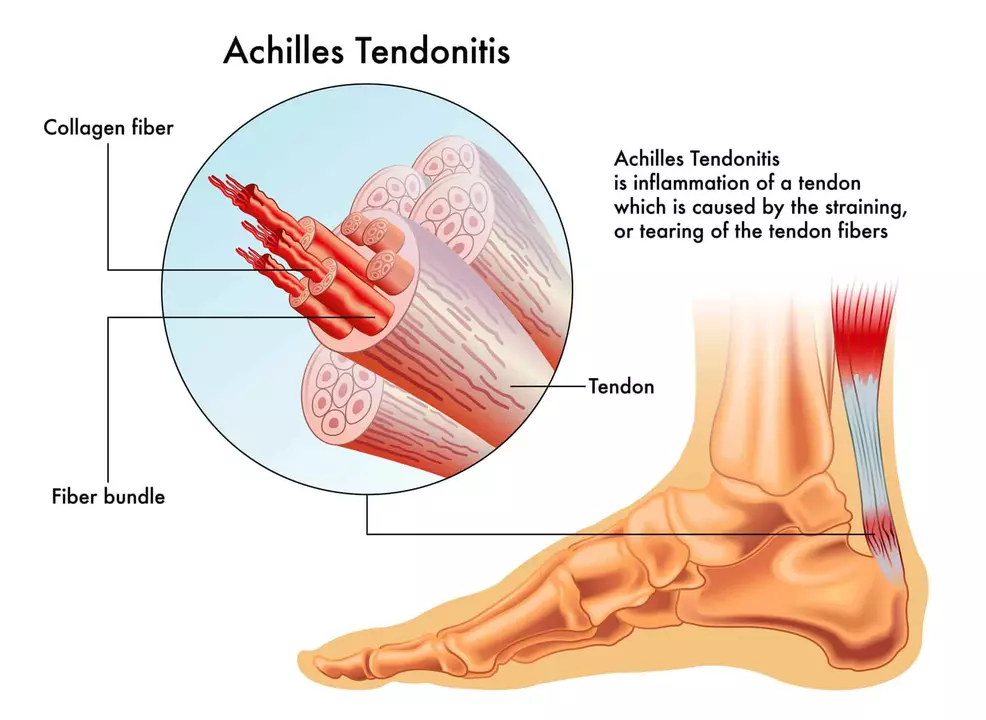Tendinosis: What It Is and How to Fix It
Tendinosis is a common tendon problem that comes from long-term wear, not short-term inflammation. Unlike tendinitis, which is inflamed and painful after an injury, tendinosis means the tendon tissue has broken down and doesn't heal well. You might feel stiffness, a dull ache, and weakness when you use the affected tendon. It’s common in the shoulder (rotator cuff), elbow (tennis elbow), Achilles, and knee tendons.
Understanding this change matters because the treatments differ. Anti-inflammatory meds and rest can ease pain at first, but they rarely fix the damaged tendon. The best approach focuses on controlled loading to help the tendon rebuild and become stronger over time.
How to treat tendinosis
Start with simple steps you can do at home: reduce activities that overload the tendon, ice after exercise, and use short-term over-the-counter pain relief if needed. Then add a structured exercise plan. Eccentric exercises (slow lengthening of the muscle) are backed by solid results for many tendons — for example, slow heel drops for Achilles tendinosis or slow wrist-lowering moves for tennis elbow. Physical therapists can teach the right technique and progress the load safely.
If pain stays after 6–12 weeks of good rehab, consider other options. Corticosteroid injections help short-term pain but may not improve tendon healing and can weaken tendon tissue if overused. Treatments like platelet-rich plasma (PRP), shockwave therapy, and dry needling show promise in some studies, but results vary. Surgery is a last resort, reserved for severe cases that don’t respond to months of rehab.
Prevention and when to see a doctor
Prevent tendinosis by building load gradually. Increase training volume or intensity no more than 10% a week, mix harder sessions with easy ones, and vary exercises to avoid repeating the same stress. Good warm-ups, proper technique, and regular strength work for surrounding muscles reduce tendon strain. If pain limits daily tasks, causes swelling, or doesn’t improve after consistent rehab for 6–12 weeks, see a doctor or physical therapist. They can check for tears, suggest imaging, and help plan next steps.
Small changes at the right time make a big difference. Start rehab early, be patient with slow improvements, and track progress. Tendons adapt slowly — consistent, sensible work usually brings real gains without risky shortcuts.
Examples: Achilles — two sets of 15 slow heel drops twice daily; start straight knee, add bent-knee after two weeks. Tennis elbow — slow wrist-lowering with light weight, three sets of 15 once a day, increase gradually. Rotator cuff — side-lying external rotations, three sets of 12. Increase load only when pain after exercise is less the next day. Expect 3–6 months for clear gains.
Support healing with good sleep, protein, and vitamin C. Some evidence suggests taking collagen before exercise may help. Avoid smoking and heavy alcohol while rehabbing. If you get sudden severe pain, a popping sound, can't use the limb, or big swelling, seek care fast — those signs may mean a tendon tear. Get help early for best results.

Tendonitis vs. Tendinosis: What's the Difference?
May 12, 2023, Posted by Mike Clayton
As a blogger, I've come across many people who get confused between tendonitis and tendinosis. It's important to understand that tendonitis is the inflammation of a tendon, typically caused by sudden injury or overuse, while tendinosis refers to chronic degeneration of the tendon due to repetitive strain. In simpler terms, tendonitis is an acute condition with inflammation, whereas tendinosis is a long-term issue resulting from wear and tear. Treatment for tendonitis generally includes rest, ice, and anti-inflammatory medications, while tendinosis may require more extensive therapy, such as eccentric exercises or even surgery in severe cases. Knowing the difference between these two conditions can help you seek appropriate treatment and prevent further damage to your tendons.
MORESEARCH HERE
Categories
TAGS
- treatment
- online pharmacy
- dietary supplement
- side effects
- health
- dietary supplements
- health benefits
- online pharmacy Australia
- medication adherence
- medication safety
- thyroid disorders
- treatment option
- calcipotriol
- blood pressure
- erectile dysfunction
- closer look
- optimal health
- sexual health
- bacterial infections
- nutrition
